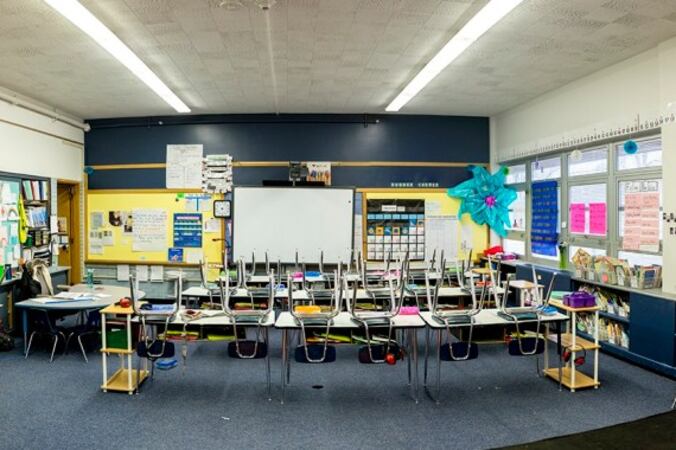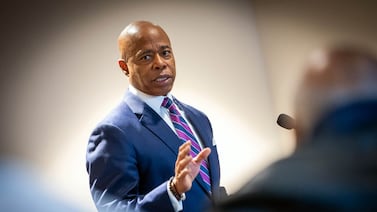In Highland Park, the small municipality within Detroit, there are more closed school buildings than open ones.
There are two old high school campuses, one nearly razed with the exception of a faded set of bleachers, and another sitting empty, dandelions growing between the cobblestones of the school’s once-grand entranceway.
And on a Tuesday night in May, a fire blazed through the building for hours, tearing through what locals feared was the school’s grand auditorium.
But in Highland Park, where the beloved school mascot was a polar bear, school leaders don’t want to be known for their closed school buildings.
So instead, they’re trying to rally the community to open one.
“Folks are incredibly proud of attending Highland Park High School and being lifetime Polar Bears,” said Anthony Askew, chair of the school district’s high school subcommittee. “I think everyone has fond memories of what that institution meant for the community, and every person that I know in this city wants to redeem that history with a new high school.”
Barber Prep, a charter school serving K-8 students, remains open, as does another K-8 charter, George Washington Carver Academy, but Highland Park has no high school to serve older students.
The city school district’s last high school closed under emergency management in 2015 because of financial problems and dwindling student enrollment. Since then, older students have had to scatter to high schools outside of their city, in Detroit and nearby suburbs.
Tesha Jordan, a Highland Park mother of 16-year-old twins Cody and Chase Knight, said that when it came time for her boys to attend high school, they “pretty much didn’t have any options” in their city.
City leaders and others say a school is necessary to revive the long-struggling enclave, once home to a thriving Ford Motor Co. plant a century ago. Quality schools are a draw for prospective community members, particularly young families with children.
More than that, Highland Park residents say they are due a complete school system. When the last remaining high school closed seven years ago, one community member called the decision a “tragedy” that uprooted children, no matter how few were left.
Shamayim Harris, widely known as Mama Shu to the community and president of Highland Park’s school board, said the district wants to be responsible for the education of all students in the community.
“We have to make sure that they’re educated properly, that they’re nurtured and that they get what they want at home, in their own environment, in their own city,” she said.
But Highland Park will struggle with scale: Part of the reason the city’s high school closed in 2015 was dwindling student enrollment, a problem that has not been resolved in seven years. Chalkbeat reported that the district announced a similar effort in February 2020, but the project never came to fruition — a pandemic did instead. Kevin Smith, the district’s director of operations, said this vision is an outgrowth of the 2020 plan, just “adjusted based on post-COVID realities.”
Plummeting enrollment, dire finances
The state took over the Highland Park City School District in 2012 because of an $11 million budget shortfall. Budgetary problems were so dire, state lawmakers had to step in so educators could receive their paychecks.
At that time, the district had lost more than a third of its students in six years, from about 3,400 students to about 1,000. When schools lose students, they also lose dollars because Michigan districts are funded per student.
In 2014, Robert Davis, a former school board member, pleaded guilty to embezzling $200,000 from the beleaguered district. He was sentenced to prison for 18 months and was released in 2016.
A state-appointed emergency manager, Joyce Parker, handed the school district to a charter school company, the Leona Group, to run Highland Park’s high school and two K-8 schools.
The high school was renamed Highland Park Renaissance Academy and operated for three years. Students kept leaving, and the school went from 423 students in 2012 to 169 in 2015, its final year, according to state data.
As that 2014-15 school year ended, officials held a fair at the school, a month after deciding to close it. About 100 parents gathered to try to find new schools for their children. Officials said any high school would be open to them.
By September 2015, Highland Park high school students had scattered to other schools across metro Detroit when the new academic year began.
“Most of them are going to Detroit schools,” Harris said. “Some go to Hamtramck schools, they go to Southfield schools, they go wherever they can go to get an education at right now.”
Donald Weatherspoon was the district’s emergency manager at the time the high school closed. In a May interview with the Detroit Free Press, he said by the time he’d come in, there were too few students for a high school to stay open.
“My main concern was education of the children, safety of the children, and the declining opportunity for access to education,” he said.
An education in their own city
Highland Park was released from emergency management in 2018. Barber Prep, with 268 students, is still run by a charter school management agency, but authorized by the city school district. In addition, nearly 400 students attend George Washington Carver Academy, also in Highland Park.
But for high school, families are left with no options.
Jordan, the mom of twin boys, would like a school closer to her home.
She has to be at work as an early Head Start teacher by 5:30 a.m. Because Highland Park doesn’t have a high school, she had to search for a school where a school bus could drop them off. The 7-mile bus ride her sons Cody and Chase take is about 30 minutes, 20 minutes if the boys are lucky, they said. If they miss the bus for any reason, they have to take the city bus, which takes about an hour.
“These children need a high school in their own direct community, teachers that they can depend on in their own community,” she said.
Longer student commute times are common in cities like Highland Park, where about 88% of residents are Black, according to census data.
According to a 2018 study by the Urban Institute, Black students are more likely to face a longer commute to schools than white and Latino peers.
Askew, a fourth-generation Highland Park resident who attended Barber Elementary in Highland Park as a kid, was elected to the school board in 2020 as a write-in candidate. In 1997, a Detroit Free Press image pictures Askew as a child waiting to see President Bill Clinton. Askew said at the time that he shared something with Clinton: “I’m the president of my school.”
But after Barber, Askew’s mother decided against sending him to Highland Park High, still open at the time, and sent him to Martin Luther King Jr. Senior High School in Detroit instead. Askew said the high school wasn’t academically competitive.
Students now should have that option in their own city, he said.
“In terms of why I’m so committed to this, is that I should have had a competitive option,” he said. “I’m in Highland Park as a person who deeply loves this place and these people. I think that I would have preferred to have had that option.”
Concerns about the quality of education in the district go back more than a decade.
In 2012, the American Civil Liberties Union sued the district on behalf of a group of parents and students, saying it failed to teach their kids how to read at a fourth grade level. The Michigan Court of Appeals dismissed the lawsuit in 2014, however.
A similar right-to-read lawsuit in Detroit ended with a settlement between students and the state.
Askew, Harris and Zakia Gibson, chief education officer for Highland Park’s school district, all say they’re committed to starting a thriving high school with high academic standards. A new principal came on in August, Gibson said.
The vision for a new high school
The board right now is looking at 2023 or 2024 to welcome a class of ninth graders in Highland Park. The plan would be to start with ninth graders and add a new class every year for four years until the district has a revolving freshman, sophomore, junior and senior class.
The school would have to begin as a charter under Highland Park’s debt elimination plan and emergency management orders, and could only be run as a district school when the district fully pays off outstanding legacy debt. That debt is at about $3.9 million, down from $4.8 million in 2020, according to a state debt report. The district can operate schools itself when all its debt is paid.
The district is in an exploratory phase, thinking about how and whether a high school is feasible.
There’s still a lot to do. The district has not yet assessed what the cost of such a project would be. It also needs to find a place to house that first class of students and has not announced any possible locations.
It also needs students. About half of Barber’s current 25 eighth grade students expressed interest in a high school when surveyed by the district, Gibson said. They want at least 25 to 100 students in each class, and are hoping to also draw from George Washington Carver, which currently has about 28 students in eighth grade.
“We’re now building a relationship with them to also recruit and encourage their eighth graders to remain within the community for their high school education,” Gibson said.
Strong districts can attract new residents to cities. But attracting new residents will be a battle for Highland Park.
Census figures show Highland Park’s population at 8,977, down from about 11,776 in 2010, with 20% of the population under 18. However, research suggests the 2020 census vastly undercounted the population in Detroit, perhaps by tens of thousands. And Black Americans across the United States were more likely to be undercounted.
State Rep. Helena Scott, a Democrat whose district encompasses northwest Detroit and Highland Park, said she has recently seen younger folks moving to Highland Park.
“Younger families moving in, they’re going to want to make sure that they have a viable school district,” she said.
Maurice Turner and his husband bought their home in Highland Park in 2019. They renovated the home on an HGTV show, “Rehab Addict Rescue,” and recently started a nonprofit organization, Rehab Highland Park, dedicated to community revitalization.
The couple loves historic homes — and Highland Park is chock-full. While many are in bad shape, Turner sees potential for new growth across the tight-knit community.
“We can’t go back and be the city that it once was, but we can move forward and start to really build a future and foundation for that future,” he said.
Turner, running for mayor later this year, said building up schools is a big part of that revival.
“Part of this is really working to rebuild our reputation of a capable and vibrant community that also has schools that the residents and the families here can put their kids into and trust that they are going to get a quality education,” he said.
Harris, the school board’s president, said creating a vibrant place for students to attend high school and feel safe in their own community will go a long way.
“I’m excited for the parents, for the community, for us to be able to feel complete,” Harris said. “It feels complete when you have a high school. It feels complete when you have schools, period, with children milling around with their positive energy. That’s what we need. And I think that a school will help to uplift this whole city.”
Lily Altavena is a reporter with the Detroit Free Press. You can contact her at laltavena@freepress.com.








